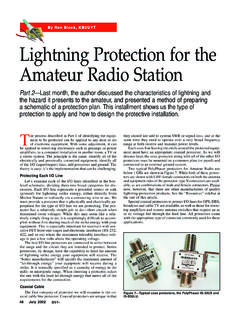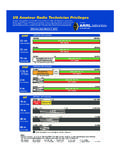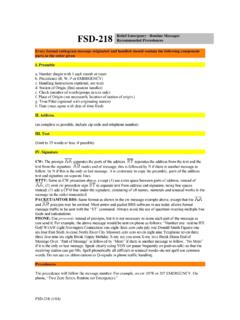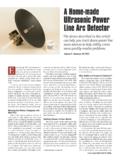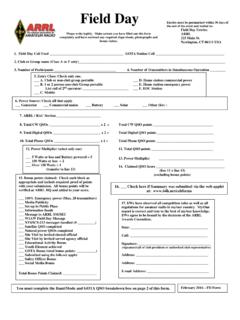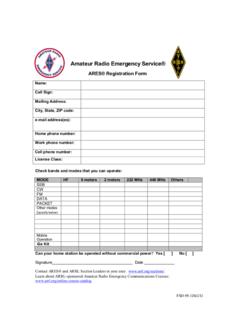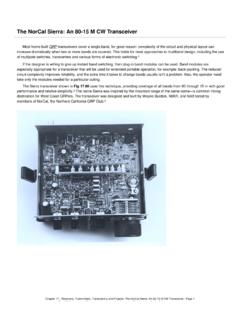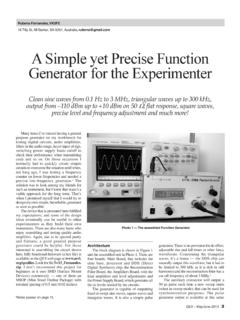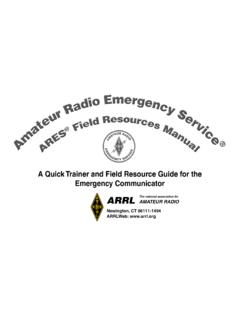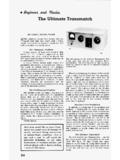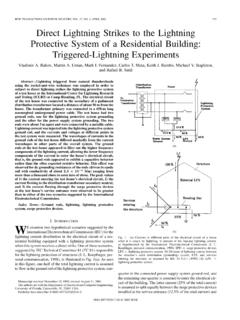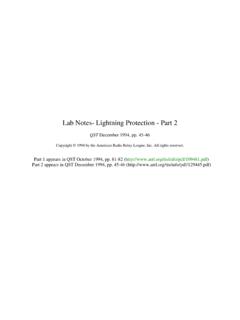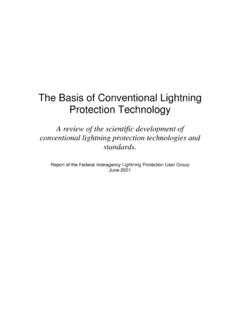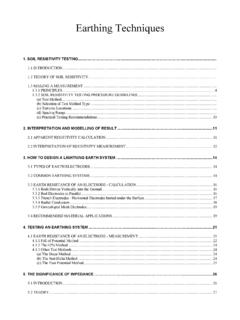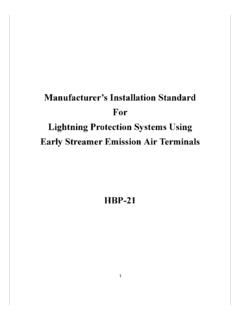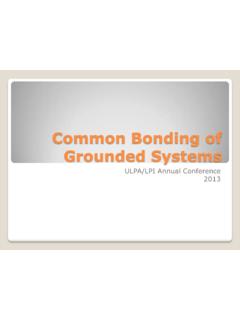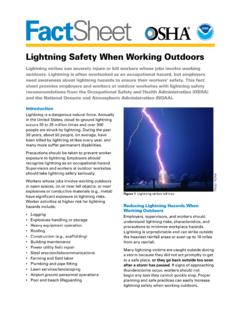Transcription of Lightning Protection for the Amateur Radio …
1 By Ron Block, KB2 UYT. Lightning Protection for the Amateur Station Part 1 Lightning Protection can be a serious issue for amateurs. In the first of this three-part series, the author leads us through the process of developing a Protection plan. Next: how to protect your equipment. The final part will cover the process of creating an effective ground system. NOAA LIBRARY. The Challenge The Amateur is challenged to assemble the best Radio sta- tion possible, enjoy the benefits of the hobby, and have the station operable during times of need. This can be a signifi- cant challenge especially considering the awesome capabili- ties of Mother Nature's Lightning strikes. While she may have the upper hand as far as when and how much energy she deliv- ers, you have the ability to influence how that energy is di- verted into the earth. Said another way, you can implement a Lightning Protection plan that will protect your Amateur Radio station, even from a direct strike!
2 The commercial Radio folks have done this for years; many of them have critical installations located on hills or mountaintops that are great Lightning strike targets. They do survive direct strikes and continue to provide important ser- vices to the communities that they serve. While this type of solution is possible for the Amateur Radio station, it does cost money and it does take a significant amount of resourceful- ness, ingenuity, and effort to implement and maintain. Figure 1 A typical convective thunderhead. The plan does work; but you must follow all of the rules . exactly. Any violation of the rules, even just a little one, may to mushroom and be pushed forward. The area of imminent result in a violation of the Protection plan and damage to your danger is the area up to 10 miles in front of the leading edge equipment. In some cases the damage to a semi-protected ra- of the cloud. dio station could be worse than if no Protection plan had been When a Lightning strike does occur, the return stroke rapidly implemented at all.
3 I'll start with some background. deposits several large pulses of energy along the leader channel. That channel is heated by the energy to above 50,000 F in only a Lightning Characteristics microsecond and hence has no time to expand while it is being The conditions necessary for an old-fashioned summer af- heated, creating extremely high pressure. The high pressure chan- ternoon thunderstorm are lots of moist air from ground level nel rapidly expands into the surrounding air and compresses it. to a few thousand feet, cooler air above with little to no wind, This disturbance of the air propagates outward in all directions. and plenty of sun to heat the air mass near the ground. As the For the first 10 yards or so it propagates as a shock wave (faster warm, moist air is heated, it rises quickly to heights where the than the speed of sound) and after that as an ordinary sound temperature is below freezing, eventually forming a thunder- wave the thunder we hear.
4 Cloud as shown in Figure 1. Within the thundercloud, the con- During a Lightning strike your equipment is subjected to stant collisions among ice particles driven by the rising air several huge impulses of energy. The majority of the energy is causes a static charge to build up. Eventually the static charge pulsed dc with a substantial amount of RF energy created by becomes sufficiently large to cause the electrical breakdown the fast rise time of the pulses. A typical Lightning strike rise of the air a Lightning strike. time is S. That translates into a radiated RF signal at The average thunderstorm is approximately six miles wide 139 kHz. Rise times can vary from a very fast S to a and travels at approximately 25 mph. The anvil shape of the very slow 12 S, yielding an RF range from 1 MHz down to cloud is due to a combination of thermal layer (tropopause) 20 kHz. However, the attachment point for a direct Lightning and upper high velocity winds that cause the top of the cloud strike has a time as fast as 10 nS.
5 This RF content of the strike 56 June 2002. 56 7/22/2002, 10:55 AM. US WEATHER BUREAU. Figure 2 This map shows the average number of thunderstorm days per year. From Technical Paper No. 19, Climatological Services Division, US Weather Bureau, 1952. The probability of having your tower struck by Lightning is governed primarily by where you are located and the height of the tower. In 1952, The Weather Bureau compiled a contour map of the US showing the mean number of thunderstorm-days that occur in a year shown in Figure 2. The counting criterion is relatively simple a thunderstorm-day is one in which one or more claps of thunder are heard. This gives us a reasonable view of the country with respect to our exposure to Lightning . The other significant factor that affects the probability of be- ing struck is the height of the tower above the average ground level. As you might suspect, the higher your tower, the higher the probability of being struck. Figure 3 shows the estimated num- ber of times per year that a tower of a given height would be struck based on the number of thunderstorm-days in your area.
6 Now that you can estimate your approximate exposure, you Figure 3 Estimated number of Lightning strikes per year based might have one of several reactions. First, you could say the on the number of thunderstorm days in your area and the predictions are all wrong personally, I have never had my height of your antenna. Based on information from Living with Lightning , Seminar Notes #ECP-826B Version F, GE Mobile 100-foot tower struck since I put it up two years ago. Maybe Radio Technical Training, GE 1985. you are just lucky or the law of averages has yet to catch up with you. Another reaction you could have is, Wow! This explains what has been happening and I had better do some- will have a major effect on the design of the Protection plan. thing about this right away.. In addition to the strike pulses, the antennas and feed lines In either case, this article shows what you need to do to form tuned circuits that will ring when the pulses hit. This is protect both your life and equipment, broken into straightfor- much like striking a tuning fork in that ringing is created from ward steps to maximize your probability of success.
7 Every the Lightning 's pulsed energy. Amateur Radio station is different and there is no one size Average peak current for the first strike is approximately 18 fits all solution. There are, however, some well grounded (pun kA (98% of the strikes fall between 3 kA to 140 kA). For the intended) principles that must be followed. A failure to follow second and subsequent impulses, the current will be about half the principles will result in the expenditure of both time and the initial peak. Yes, there is usually more than one impulse. money with no better Protection (possibly even worse dam- The reason that we perceive a Lightning strike to flicker is that it age) than if you had done nothing at all. Please follow each is composed of an average 3 to 4 impulses per Lightning strike. step carefully, thinking about the principles involved, and care- The typical interval between impulses is approximately 50 mS. fully apply the information to your specific installation.
8 Vulnerability Identify What is to be Protected Frequently, amateurs provide an inducement for Mother Na- The goal of the planning process is to establish a zone of ture to find us. For good long distance communications, we Protection within the Radio room, as opposed to the whole put our antennas on the top of towers and place the towers so house or building. Additional zones may be considered sepa- that they protrude above the surrounding buildings or coun- rately. The first step in the process is to identify what you tryside. While this provides for great signal coverage, it also want to protect. The immediate answer is, well, everything. makes it easier for Mother Nature to find a shorter, conductive While you can come close, you may run out of money, time, path to ground. or energy. So let's create a priority list and work the list from June 2002 57. 57 7/22/2002, 10:55 AM. number and each feed line with connector type and gender, frequency range, and maximum transmit power.
9 Figure 4 shows a block diagram for a simple station. The block diagram should now have a rectangle representing each piece of Radio equipment and accessories in the Radio room. Each of the rectangles should have lines representing the inter- connecting cables and feed lines. Each feed line that leaves the Radio room and goes to an antenna or some tower-mounted elec- tronics should be drawn to the edge of the page and labeled. A Close Look Now it is time to examine each of the rectangles, one at a time, and to add to the diagram any other electronic devices (as rectangles), complete with the electrical connections Figure 4 Block diagram of a typical simple HF Radio station. and interconnections between them. Some of these will be easy and intuitive, while others will require a little more crawling high to low priority. Probably first on the list are the more around behind the equipment. Every connection must be expensive items associated with your Radio station, usually the included this is important to the integrity of the solution.
10 The transmitting and receiving equipment. Viewed another way, only exception is a non-conductive fiber-optic connection. without these there is no Radio station, so they should be very To complete the diagram in an orderly fashion, pick a rect- near the top of the list. What follows on the list depends on angle and answer all of the following questions for that rect- just how you enjoy the hobby the antenna tuner, linear am- angle. Then, pick another rectangle and do the same until all plifier, terminal node controller, or computer. Further down of the rectangles have been examined. the list might be the antenna, rotor and transmission line. Each Is there a connection between this rectangle and any other person's list and priority ordering will be different. Pause here rectangle? If so, add a line between the respective rectangles and mentally construct your priority list, being sure to include and label its function. all the elements of your Radio station.
